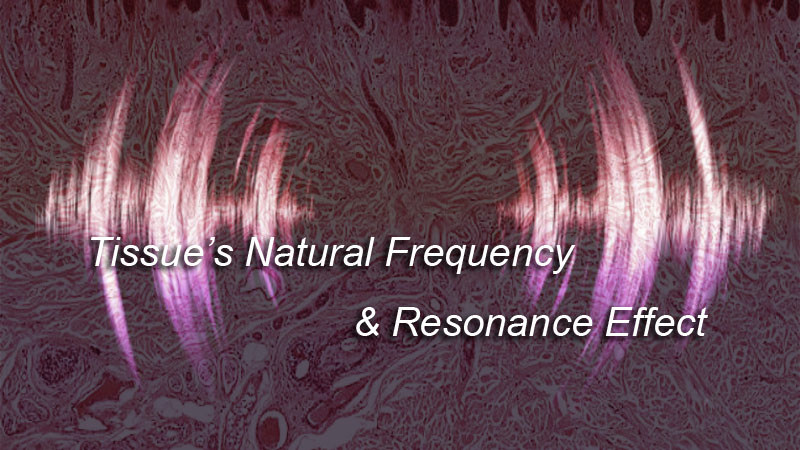Resonance Frequency of Soft Tissues

Resonance Frequency of Soft Tissues
Vibration frequency is the most importation parameter to decide for anyone to start using a vibration plate.
Vibration therapy is to use vibration to produce a suitable mechanical stimulation on human body in order to achieve certain positive results for health improvement.
Frequency and amplitude are the two most important parameters that decide the intensity of vibration.
First we need to know how our body and tissues respond to different vibration frequency.
Resonance
In a vibration transfer process, at a certain input vibration frequency, the recipient object can achieve the highest responding vibration amplitude. The phenomenon that the recipient object respond with the highest amplitude is called resonance. The frequency at which the resonance happens is called resonance frequency of the object. It is also called the natural frequency of the project.
The natural frequency of an object is decided by its mass and rigidity. A light and rigid object has a higher natural frequency. A large and flexible object has a lower natural frequency.
The Natural Frequency of Human Body
Human body-as-a-whole has a big mass and is flexible. Therefore, the body-as-a-whole has a lower natural frequency, between 5Hz to 10Hz, depending on the body weight and the rigidity.
For human body as an object, the rigidity is also affected by body posture and vibration direction. If you tense your body on a certain direction, your natural frequency increase in that direction. If you relax, your natural frequency decrease. To a certain extend, you decide your natural frequency!
Anyway, with the natural frequency ranged between 5Hz and 10Hz, your body-as-a-whole can achieve the highest vibration amplitude on a pivotal oscillation vibration plate which usually vibrate below 15Hz. You experience your body swings from side to side.
For vibration therapy, however, the goal is not to swing the body, but to vibrate the skeletal muscles to induce intensive skeletal muscle contraction. Body swinging at low frequency does not produce much muscle contraction.
Natural Frequency of Soft Tissues
Compared with the body-as-a-whole, soft tissues are also flexible, but smaller in mass. Their natural frequencies are higher, in a range between 10Hz and 30 Hz.
Among soft tissues, skeletal muscles are very special in term of their natural frequency. When vibrated, skeletal muscles respond with contraction, and therefore increase their rigidity, raising their natural frequency. Skeletal muscles always poise to keep their natural frequency higher than the input frequency.
Skeletal Muscle Against Resonance
Naturally, skeletal muscles tend to hold their muscle length. If stretched, skeletal muscles spontaneously contract. This is called skeletal muscle’s stretch reflex response.
When muscles contract, they become more rigid, and their natural frequencies increase.
When vibrated, the stretch reflex response of skeletal muscles always react to refuse resonance. They tend to damp the vibration by increasing their natural frequencies above the input frequency, so as to stay out of resonance state.
Therefore, skeletal muscles always react to reduce the resonance effect through contraction. This is an important effect we want for vibration therapy to work - letting our muscles to work, on fast pace.
Because of their amplitude damping nature, skeletal muscles do not appear swinging much in vibration. Instead, they keep high tension, and work hard to damp the vibration.
When a skeletal muscle contracts to its own limit, it reaches its highest rigidity as well as its highest natural frequency.
The highest natural frequency that skeletal muscles usually achieve is around 50Hz.
Without contraction, the skeletal muscles’ natural frequency is around 10Hz.
In vibration exercise, if skeletal muscles are observed swinging loosely, it means the muscles are not actually doing much contraction, because the vibration frequency is too low so the skeletal muscles do not need to do much work to damp the vibration.
Frequency for Vibration Therapy
Intensive and fast pace skeletal muscle contraction produces a unique mechanical stimulation to our body system. Such stimulation can activate our body systems and tissues, and potential influence the cellular processes.
To achieve the needed skeletal muscle contraction, the input vibration frequency should be above 15Hz, to effectively trigger skeletal muscles stretch reflex respond.
Depending on the degree of contraction, skeletal muscles’ natural frequencies are in the range between 10Hz and 50Hz. Most linear vibration plates are designed to work in this range.
Reference:
- Muscle activity damps the soft tissue resonance that occurs in response to pulsed and continuous vibrations
- By James M. Wakeling, Benno M. Nigg, and Antra I. Rozitis Journal of Applied Physiology
- Jay Tang
- About
-
Interpreting life science from a mechanical engineering perspective.
